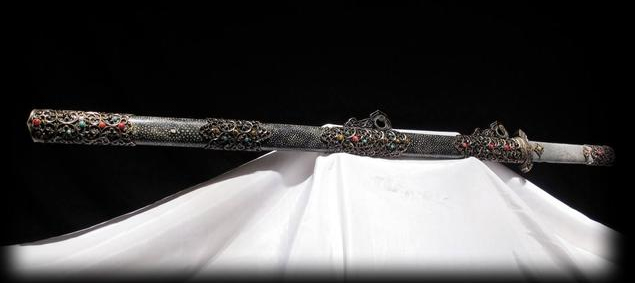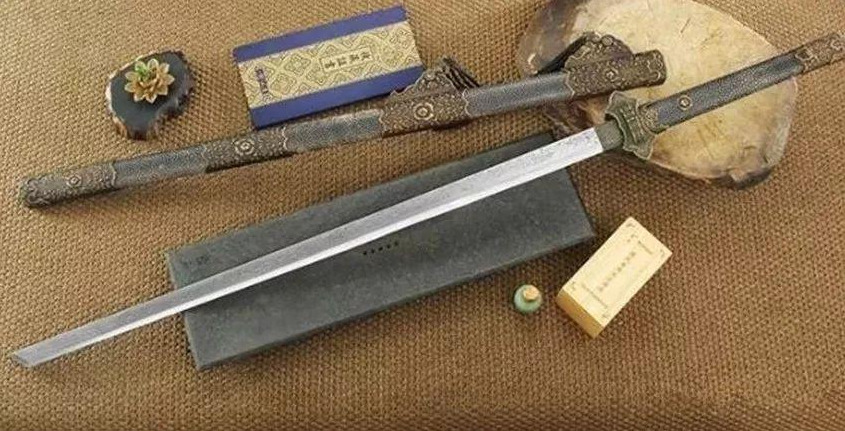The forging method of the origin of Chinese Tang Dao


Through enlightened politics and powerful military power, the Tang Empire became the center of the world at that time.
From the unification war in the early Tang Dynasty to the heyday of the Tang Dynasty, all internal and external wars appeared in the history of Cold Weapon, a weapon that had a huge impact on later generations-Tang Dao.
In the world at that time, Tang Dao were two famous swords that were well-known to the world as the Arab Damascus swords. Both technically and artistically, they reached extremely high achievements, which can be said to be the pinnacle in the history of Chinese swords.
The origin of Tang Dao
The ancestor of Tang Dao was Han swords(also known as ring first swords). Most Han swords were single-handed swords with short handles ranging from 58 to 114 cm in length, and without exception, an oblate ring was made on the outside of the handle. The shape, the ring first sword is also named. Tang Dao was developed on the basis of Han Dao. The Tang sword adopts the "Hundred Steelmaking" forging process of the Han sword, and improves the treatment of impurities in the steel during forging, and creates the "clad steel" technology, which makes the Tang Dao harder on the outside and soft on the inside. Of resilience. While improving the forging process, the appearance is also greatly improved. The Tang Dao removes the flat ring of the head of the Han Dao; the blade is widened and the handle is extended so that the Tang Dao can be held in both hands. The above improvements have made Tang Dao a qualitative leap compared to Han swords. It is not only more ornamental in appearance, but also truly improves the actual combat performance and durability, so that Tang Dao can split any armor and equipment. In the Tang Dynasty in history, there were only swords but no swords. At that time, the name sword was actually the Tang Dao.
The real Tang dao craftsmanship made the cost of Tang Dao too expensive. Therefore, in Chinese history, only the Tang Dynasty used such a sophisticated weapon. Many celebrities at the time only made a superior Tang Dao. Run out of wealth.
In the Tang Dynasty, the Tang dao was introduced to Japan. At that time, Japan had already acquired the smelting skills of the Han sword. However, when the Emperor of Japan saw the Tang dao, he said in amazement: Only the Central Plains can make such a sophisticated sword. Japan immediately learned the forging method of the Tang sword and improved it to become the Japanese sword, one of the three famous swords in the world seen today. After the Tang Dynasty, the Chinese Tang dao forging skills gradually lost its way. Even with the current modern craftsmanship, it is impossible to replicate a real Tang dao.

Tang Dao's forging method
Based on the profound foundation of the previous generations, the Tang dao was finally born. It inherits the fine traditions of Chinese swords. After absorbing the technology of 100 steel making and local quenching, it adds soil burning blade and clad steel. The technology has formed a new style of Chinese war swords.
First of all, we still need to introduce the two advanced sword-making techniques, clay tempered and kobuse.
Clay tempered, to put it bluntly, is a partial quenching technique. The basic method is to cover the parts of the blade where high hardness is not required with the mixed soil, and then heat the sword to a specific temperature. When the red hot blade enters the water, the naked part cools quickly, and the temperature change of the mud-covered part will not be very obvious, resulting in a hardness different from that of the naked part. In this way, the different cooling rates of different parts of the blade can be accurately controlled. The cooling rate is proportional to the hardness and inversely proportional to the toughness.
In addition, the Hundred Steelmaking technology means that people consciously increase the frequency of folding and forging when making utensils. A piece of steel often needs to be beaten and burnt, burnt and beaten, repeated many times, even hundreds of times. Hundred Steelmaking has more carbon content, finer structure and more uniform composition, so the quality of steel has been greatly improved.
Kobuse technology is a sword-making technology invented after deep research and understanding of steel. The main method is to sandwich soft low-carbon steel in V-shaped hard high-carbon steel; A piece of high-carbon steel is sandwiched between the carbon steel. Both of these technologies embody the basic idea of "good steel is used on the blade" to make superior swords, and also make steel swords have excellent toughness. As a result, Tang Dao became one of the best swords in the world at that time.
Of course, in terms of materials, the Chinese in the Tang Dynasty still put a lot of thought into it. At that time, the best steel in the world—Indian Uzi steel, which is known as Damascus steel (called at the time as wrought iron), was favored by Chinese cutlers and became an indispensable raw material for high-end steel swords. The average price was higher than that of ordinary steel. Three times the premium steel sword.
The horizontal sword manufactured under the above technology played a great role in the war of the Tang Dynasty. It can be used for both walking and riding. The shape is divided into two-handed grips and one-handed grips. The shape still inherits the shape of the ring-first knife in the Han Dynasty. Straight blade, but without the ring shape of the Han Dynasty. In actual combat, one-handed horizontal swords are basically used, and two-handed swords are generally used for ceremonial purposes. The high-end horizontal sword handle is wrapped with a wooden clip with an iron stem, wrapped with a silk rope, and the head of the sword is wrapped with metal ornaments. The handle and sheath are both inlaid with gold and jade, and wrapped in shark leather. The decoration is very gorgeous, reflecting the Tang Dynasty. Graceful and luxurious style of a great country.
Want a unique sword? Feel free to contact us:
Phone: 086 13739276006
Email: [email protected]
Website: www.hanbonforge.com
Custom Sword Page: www.hanbonforge.com/CUSTOM-SWORDS/Custom-Your-Own-Swords

Leave a Comment